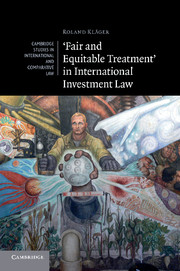Book contents
- Frontmatter
- Contents
- Foreword
- Acknowledgements
- Table of cases
- Table of treaties
- List of abbreviations
- 1 Introduction
- Part I The construction of fair and equitable treatment
- Part II The concept of fair and equitable treatment
- Part III The position of fair and equitable treatment in the international legal system
- 8 Fair and equitable treatment in the system of international law sources
- 9 Fair and equitable treatment in the system of international investment law
- 10 Conclusion
- Bibliography
- Index
- misc-endmatter
8 - Fair and equitable treatment in the system of international law sources
Published online by Cambridge University Press: 05 July 2011
- Frontmatter
- Contents
- Foreword
- Acknowledgements
- Table of cases
- Table of treaties
- List of abbreviations
- 1 Introduction
- Part I The construction of fair and equitable treatment
- Part II The concept of fair and equitable treatment
- Part III The position of fair and equitable treatment in the international legal system
- 8 Fair and equitable treatment in the system of international law sources
- 9 Fair and equitable treatment in the system of international investment law
- 10 Conclusion
- Bibliography
- Index
- misc-endmatter
Summary
A The categorisation of fair and equitable treatment
While the previous chapters tried to map out a possible way to construct a concept for fair and equitable treatment, this part seeks to embed this concept into the wider context of the international legal system. Thereby, the insights gathered earlier are necessary to embed fair and equitable treatment and gain a more comprehensive picture of this norm and its legal context. Before considering fair and equitable treatment in relation to the system of international investment protection standards and the overarching system of international economic law, the position of fair and equitable treatment in the system of international law sources will first be examined.
The three main sources of international law – treaties, custom and general principles of law – are most authoritatively described in Article 38(1) of the ICJ Statute, which provides:
The Court, whose function is to decide in accordance with international law such disputes as are submitted to it, shall apply
(a) international conventions, whether general or particular, establishing rules expressly recognized by the contesting states;
(b) international custom, as evidence of a general practice accepted as law;
(c) the general principles of law recognized by civilized nations …
Based on the present concept of fair and equitable treatment, the analysis of its legal character will embrace the norm itself as well as the previously described principles connected to fair and equitable treatment.
- Type
- Chapter
- Information
- 'Fair and Equitable Treatment' in International Investment Law , pp. 261 - 280Publisher: Cambridge University PressPrint publication year: 2011

